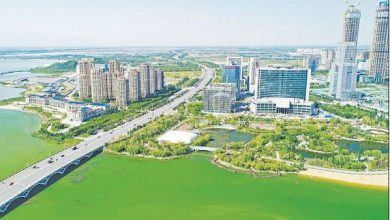How risky is building skyscrapers near coral reefs?

THOUGH I may not have an engineering background, I have a passion for thinking broadly and deeply, driven by curiosity and a love for knowledge.
This often leads me to explore ideas beyond my immediate field, drawing connections between disciplines and seeking a deeper understanding of how things work. Meaningful progress, I believe, comes from asking bold questions, challenging assumptions and being willing to learn continuously.
Knowledge is not just about facts but about seeing patterns, anticipating challenges and imagining possibilities. In that spirit, I have reflected on the implications of constructing tall structures in areas surrounded by coral reefs—particularly along coastal regions such as Oysterbay, the Msasani Peninsula and Kigamboni in Dar es Salaam.
While these developments are symbols of progress, they raise concerns about longterm environmental and climatic impacts. Many longtime residents would agree that these structures have contributed to rising heat levels, changes less evident in the past even under the pretext of climate change.
I am inclined to believe that the original planners and builders of Dar es Salaam, especially during colonial times and early independence, carried foresight for balancing urban growth and environmental preservation.
They may have anticipated potential dangers in the areas I mentioned, as well as similar regions in Tanga, Lindi and Mtwara. Yet despite our best efforts to downplay the matter, I fear our generation may overlook these warnings. Much of the land in Oysterbay and the Masaki Peninsula rests on coral reef-based geology.
Excavations for tall buildings reveal the fragility of these foundations. This raises questions: ‘What regulations guide construction here and do decision-makers fully consider environmental impacts before approving projects?’ Height restrictions exist to prevent buildings from exceeding the land’s natural bearing capacity and to preserve the flow of sea breezes, nature’s own system of air circulation.
ALSO READ: Obstacles at 100m-Muhoro Bridge removed as construction hits 48 percent
Those who came before us recognised the importance of the land’s rock formations and adapted construction methods accordingly. When I first visited Dar es Salaam in 1976, the Oysterbay and Msasani I saw then were vastly different from today.
This transformation prompts an important question: ‘How have these high-rise developments affected both land capacity and urban climate, particularly sea breeze circulation?’ It would be worthwhile to study whether continued high-rise expansion in coastal areas could influence temperature or airflow patterns.
Such research could guide urban planning to ensure harmony between development and environment. With the rapid rise of apartment and commercial complexes—many driven by joint ventures—it is timely to examine the sustainability of these projects in coral reefbased zones.
Encouraging such research could help authorities ensure Dar es Salaam grows while safeguarding its natural foundations and livability for future generations.
I share these reflections without malice, simply thinking about why certain regions were originally designated for specific types of construction. Each time I see new projects in Masaki and Oysterbay, I pause to reflect on what they may mean for the city’s future.
Despite technological advances, I often wonder: ‘Is this wave of development driven purely by finance or does it reflect gaps in understanding how building on delicate rock formations may affect both the environment and long-term structural integrity?’ This is not to cast blame but to encourage inquiry into balancing progress and sustainability.
I am not an engineer, yet I believe coral rock—or coral rag—is a porous, uneven limestone formed from ancient reefs, behaving differently from more compact rock formations.
High-rises on coral rock may initially seem profitable but carry significant risks over time. I would like engineers to provide insights into load-bearing capacity in these areas, as coral rock may have low and variable strength.
High-rise buildings in the Msasani Peninsula and Oysterbay could impose vertical and lateral loads that exceed the natural strength of coral-based ground, increasing the risk of uneven settlement, foundation cracking or other structural challenges.
Developers often use deep foundations such as piles, to reach stable layers, but rapid growth makes the future uncertain. Other challenges include subsurface voids and sinkholes, as coral rock’s porous nature can collapse under pressure.
ALSO READ: Simba stadium construction to commence in Jan
Although Dar es Salaam is not in an earthquake-prone zone, even mild seismic activity could pose safety concerns, with potential costs to life, property and investments—including insurance. Joint venture investments may deliver short-term satisfaction, but long-term risks such as water table shifts, flooding and environmental impacts could affect sustainability.
High-rises in the Masaki/ Oysterbay peninsula may also alter wind flows and exacerbate urban heat by blocking sea airflow, alongside overloading sewage, drainage and water systems not designed for vertical density.
These are risks waiting to happen. Given these uncertainties, authorities, urban planners and research institutions should undertake a comprehensive study of construction on coral-based grounds, particularly in high-rise zones like Oysterbay and Msasani.
Evidence-based research could guide development in a way that balances economic growth with environmental and structural safety. As a Chinese proverb states, “One cannot speak with authority without first conducting research.”





